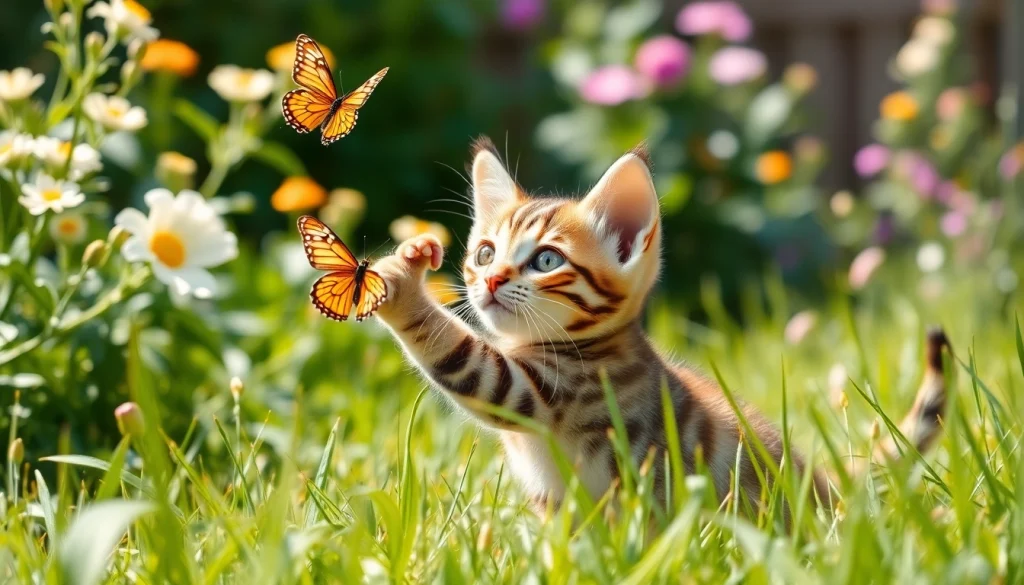Introduction to Bengal Breeders in Orange County
Bengal cats have gained immense popularity due to their captivating personalities and stunning appearance. These cats resemble wild felines with their luxurious coats and striking patterns, yet they are domesticated companions that bring joy and energy to households. With this growing interest in Bengal cats, finding reputable Bengal breeders in Orange County becomes a vital task for prospective cat owners. This article delves into what defines a reputable breeder, the adoption process, care considerations, and tips for building a lasting relationship with your Bengal cat.
What Sets Bengal Cats Apart?
Bengal cats are renowned for their exotic appearance, reminiscent of leopards and ocelots. Their most distinguishing features include:
- Unique Coat Patterns: Bengals have a diverse range of coat patterns, including rosettes, marbled, and spotted. Each pattern is distinct, showcasing the breed’s wild ancestry.
- Muscular Build: These cats are medium to large in size, characterized by a strong and muscular build. They are agile and love to play, making them entertaining companions.
- Active Personality: Bengals are known for their playful, curious, and energetic nature. They require substantial interaction and engagement to keep them happy.
This breed is not only stunning to look at but also possesses an engaging personality, making them ideal pets for active families and individuals willing to invest time in their care.
Understanding the Bengal Breed Standard
The Bengal breed standard, established by organizations like TICA (The International Cat Association), outlines the characteristics and qualities a Bengal cat should possess. Important aspects of the standard include:
- Physical Traits: The breed’s preferred build is muscular and athletic, with a medium-sized head, large ears, and expressive eyes.
- Coat Color and Texture: Bengals boast a soft, luxurious coat with a glittering quality. The coat may exhibit a variety of colors, from golden and brown to snow and silver.
- Temperament: Bengals are expected to be confident and social. They thrive in environments that allow for exploration and play.
Understanding these standards is crucial when assessing a breeder’s kittens to ensure that potential pets align with the breed’s characteristics.
Importance of Choosing TICA-Registered Breeders
When selecting a breeder, it’s paramount to choose one that is TICA-registered. TICA sets ethical standards that breeders must adhere to, including:
- Health Tests: Registered breeders often conduct health tests for common conditions in Bengals, such as Hypertrophic Cardiomyopathy (HCM), ensuring that the kittens bred are healthy.
- Ethical Breeding Practices: TICA-registered breeders follow guidelines that prioritize the welfare of the cats, thus reducing the risk of genetic issues.
- Quality Over Quantity: Responsible breeders focus on producing a limited number of litters while ensuring that each kitten is well socialized and cared for.
Opting for a TICA-registered breeder means taking an important step towards an ethical and informed choice in expanding your family with a Bengal cat.
Finding Reputable Bengal Breeders in Orange County
With many breeders available, determining who to trust can feel overwhelming. Here are essential factors to consider when searching for a reputable Bengal breeder.
Researching Breeder Credentials and Reviews
The first step in finding a reliable Bengal breeder is conducting thorough research. Look for:
- Online Presence: A reputable breeder should have an established online presence that includes testimonials from other buyers.
- Social Media and Forums: Platforms such as Facebook, Instagram, and cat forums can be invaluable for finding real-world experiences of other Bengal owners.
- References: Good breeders will be willing to provide references. Reach out to previous customers to gauge their satisfaction with the breeder’s service.
How to Ask the Right Questions
When speaking with potential breeders, having a set of prepared questions can help you evaluate their professionalism. Consider asking:
- What health tests have you conducted on the parent cats?
- Can I see the breeding environment and where the kittens are raised?
- What is your policy on returning a kitten if circumstances change?
- Can you provide documentation of TICA registration for your cattery?
These questions not only showcase your commitment as a potential owner but also help gauge the breeder’s knowledge and ethical practices.
Identifying Red Flags When Choosing a Breeder
Not all breeders operate with integrity. Here are some warning signals to keep an eye on:
- Lack of Transparency: If a breeder is unwilling to provide information about their practices or health testing, it’s a red flag.
- Overly Increased Supply: Breeders who continually have available litters may be prioritizing profit over the welfare of their cats.
- Poor Living Conditions: If the cattery is disorganized or unhygienic, this may indicate neglect.
Being aware of these red flags helps ensure you choose a responsible breeder who genuinely cares for their Bengals.
Understanding the Adoption Process for Bengal Kittens
Adopting a Bengal kitten is a rewarding experience, but it comes with its own set of responsibilities and procedures. Knowing what to expect can ease the transition into cat ownership.
Steps Involved in Adopting a Bengal Kitten
The adoption process typically involves several steps:
- Application Form: Most breeders will require an application form to understand your experience with pets.
- Home Visit: Some breeders may conduct a home visit to ensure that your living environment is suitable for a Bengal.
- Deposit Payment: After an application is approved, you may be asked to place a deposit to secure your chosen kitten.
- Final Payment: The final payment usually occurs before you take the kitten home, after which the paperwork and health guarantees will be provided.
What to Expect During the Adoption Visit
Your visit to the breeder should be informative and insightful. Here’s what to expect:
- Interaction with Kittens: Spend time observing the kittens’ behavior and interactions with you and their siblings.
- Meeting the Parents: Meeting the mother (and possibly father) can give insight into the temperament and health of your future kitten.
- Health Documentation: Be sure to ask about vaccinations and health guarantees before you agree to the adoption.
Preparing Your Home for a New Bengal Kitten
Once you’ve completed the adoption process, it’s crucial to prepare your home for the new arrival:
- Safe Space: Create a designated area with food, water, litter box, and toys where your kitten can feel secure.
- Toy Selection: Invest in engaging toys that stimulate their natural hunting instincts.
- Cat-Proofing: Ensure that your home is safe by securing windows, removing hazardous items, and storing away toxic plants.
Preparations like these help ease the transition for your new Bengal, ensuring a smoother integration into your family life.
Health Considerations with Bengal Cats
Like all pets, Bengals require diligent health management to thrive. Here’s what you need to know:
Common Health Tests for Bengal Cats
Recognizing potential health issues early is critical. Common health tests include:
- Hypertrophic Cardiomyopathy (HCM): A common heart condition in Bengals that requires regular screenings.
- Progressive Retinal Atrophy (PRA): This genetic condition can lead to vision loss; testing helps identify carriers.
- Feline Leukemia and FIV: Tests for these viral diseases are crucial to ensure that kittens are negative before entering their new homes.
It’s essential to ensure that your breeder conducts these tests as part of their commitment to producing healthy kittens.
Nutrition and Diet for Optimal Health
A balanced diet is vital for a Bengal’s health, including:
- High-Quality Protein: Bengals require diets rich in animal protein to support their active lifestyle.
- Essential Nutrients: Look for foods that contain taurine, fatty acids, vitamins, and minerals.
- Hydration Needs: Ensure access to fresh water at all times and consider wet food as a hydration source.
Consulting with a veterinarian can help tailor your Bengal’s diet to their specific needs, optimizing their health and longevity.
Grooming Needs of Bengal Cats
Bengals do not require extensive grooming due to their short coats, but regular maintenance is advisable:
- Brushing: Weekly brushing helps reduce shedding and keeps their coat healthy.
- Nail Trimming: Regular nail trims prevent overgrowth and associated issues.
- Ear Cleaning: Check and clean their ears regularly to prevent wax buildup.
Incorporating grooming into your cat’s routine helps foster a bonding experience while maintaining their physical health.
Building a Relationship with Your Bengal Cat
Developing a strong bond with your Bengal cat involves understanding their behavior, needs, and preferences.
Socialization Tips for Bengals
Bengals thrive on interaction and socialization. Here are ways to engage:
- Interactive Play: Utilize interactive toys that mimic prey to engage your cat’s hunting instinct.
- Regular Handling: Consistent, gentle handling early on fosters trust and builds a strong relationship.
- Visitor Exposure: Introduce your Bengal to a variety of people and environments to help them become adaptable and confident.
Understanding Bengal Behavior
Understanding your Bengal’s unique behavior is key to effective communication and training:
- Vocalization: Bengals are known for their distinctive vocalizations. Pay attention to their sounds as a form of expression.
- Curiosity: Their adventurous nature means they love to explore. Be prepared for them to climb or investigate various spaces.
- Affectionate Traits: Bengals often seek companionship from their owners, enjoying cuddles and pets.
Training Your Bengal for Good Behavior
Positive reinforcement is the best way to train your Bengal. Here are some tips:
- Clicker Training: This method utilizes sound to mark good behavior, followed by a reward, which accelerates learning.
- Consistency: Maintain a consistent routine for feeding, playtime, and interactions to reinforce desired behaviors.
- Socialization Skills: Expose your Bengal to different people, pets, and environments to build confidence and reduce anxiety.
Building a strong relationship takes time and effort, but the rewards of having a happy, well-adjusted Bengal cat are immeasurable. By following these guidelines on health, welfare, and training, you set the stage for a long, fruitful companionship.


